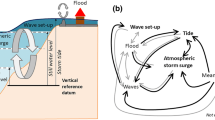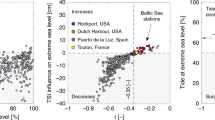Abstract
The research presented in this paper involves the application of the joint probability method to the estimation of extreme water levels resulting from astronomical tides and surge residuals and the investigation of the effects of tide–surge interactions on extreme water levels. The distribution of tide peaks was analysed from field records (<20 years) and a 46-year dataset of monthly maximum tidal amplitudes. Large surges were extracted from both field records and a numerical model hindcast covering the 48 largest storm events in the Irish Sea over the period 1959–2005. Extreme storm surges and tides were independently modelled using the generalised extreme value statistical model, and derived probability distributions were used to compute extreme water levels. An important, and novel, aspect of this research is an analysis of tide–surge interactions and their effects on total water level; where interactions exist, they lead to lower total water levels than in the case of independency. The degree of decrease varies with interaction strength, magnitude of surge peak at a particular phase of tide and the distribution of peaks over a tidal cycle. Therefore, including interactions in the computation of extreme levels may provide very useful information at the design stage of coastal protection systems.











Similar content being viewed by others
References
Amin M (1982) On analysis and prediction of tides on the west coast of Great Britain. Geophys J R Astron Soc 68:57–78
Butler A, Heffernan JE, Tawn JA, Flather RA, Horsburgh KJ (2007) Extreme value analysis of decadal variations in storm surge elevations. J Mar Syst 67:189–200
Coles SG (2001) An introduction to statistical modelling of extreme values. Springer, London
D’Onofrio EE, Fiore MM, Romero SI (1999) Return periods of extreme water levels estimated for some vulnerable areas of Buenos Aires. Cont Shelf Res 19:1681–1693
Dixon MJ, Tawn JA (1994) Extreme sea levels at the UK A-class sites: site-by-site analysis. POL internal document No. 65
Garrity NJ, Battalio PE, Hawkes PJ, Roupe D (2006) Evaluation of event and response approaches to estimate the 100-year coastal flood for Pacific coast sheltered waters. 30th Int. Conf. Coastal Engineering, San Diego, pp 1651–1663
Haigh ID, Nicholls R, Wells N (2010a) A comparison of the main methods for estimating probabilities of extreme still water levels. Coast Eng 57:838–849
Haigh ID, Nicholls R, Wells N (2010b) Assessing changes in extreme sea levels: application to the English Channel, 1900-2006). Cont Shelf Res 30:1042–1055
Halcrow (2008) Lee catchment flood risk assessment and management study. Hydrology Report, April. OPW, Ireland
Hawkes PJ (2008) Joint probability analysis for estimation of extremes. J Hydraul Res 46(Extra Issue 2):246–256
Hewitt RL, Lees-Spalding IJ (1982) The Maximillan and Silk Cut nautical almanac. The Macmillan Press Ltd
Horsburgh KJ, Wilson C (2007) Tide–surge interaction and its role in the distribution of surge residuals in the North Sea. J Geophys Res 112:C08003. doi:10.1029/2006JC004033
Howard T, Lowe L, Horsburgh K (2010) Interpreting century-scale changes in southern North Sea storm surge climate derived from coupled model simulations. J Clim 23:6234–6247
Jones JE, Davies AM (1998) Strom surge computations for the Irish Sea using a three-dimensional numerical model including wave-current interaction. Cont Shelf Res 18:201–251
Jones JE, Davies AM (2006) Application of a finite element model (TELEMAC) to computing the wind induced response of the Irish Sea. Cont Shelf Res 26:1519–1541
Kidner D, Dorey M, Smith D (1999) What’s the point? Interpolation and extrapolation with a regular grid DEM. In Proceedings 4th International Conference on GeoComputation, Mary Washington College Fredericksburg
Lowe JA, Gregory JM, Flather RA (2001) Changes in the occurrence of storm surges around the United Kingdom under a future climate scenario using a dynamic storm surge model driven by the Hadley Centre climate models. Clim Dyn 18:179–188
Lyard F, Lefevre F, Letellier T, Francis O (2006) Modelling the global ocean tides: modern insights from FES2004. Ocean Dyn 56:394–415
McInnes KL, Macadam I, Hubbert G, O’Grady J (2011) As assessment of current and future vulnerability to coastal inundation due to sea-level extremes in Victoria, southeat Australia. Int J Climatol. doi:10.1002/joc.3405
McRobie A, Spencer T, Gerritsen H (2005) The big flood: North Sea storm surge. Philos Trans R Soc Lond A 363:1263–1270
Meadowcroft IC, Hawkes PJ, Surendran S (2004) Joint probability best practice guide: practical approaches for assessing combined sources of risk for flood and coastal risk managers. Defra Flood and Coastal Management Conference, University of New York, 6a(2), pp 1–10
NOAA (1982) Computer Applications to Tides in the National Ocean Survey. Supplement to the Manual of Harmonic Analysis and Prediction of Tides (Special Publication No. 98). National Ocean Service, National Oceanic and Atmospheric Administration, US Department of Commerce, January 1982
Olbert AI, Hartnett M (2010) Storms and surges in Irish coastal waters. Ocean Model 34:50–62
Owen MW, Hawkes PJ, Tawn JA, Bortot P (1997) The joint probability of waves and water levels: a rigorous but practical new approach. MAFF Conf. River and Coastal Engineering, University of Keele, B(4), pp 1–10
Prandle D, Wolf J (1978) The interaction of surge and tide in the North Sea and river Thames. Geophys J R Astron Soc 55:203–216
Proudman J (1955) The propagation of tide and surge in an estuary. Proc R Soc Lond A231:8–24
Proudman J (1957) Oscillations of tide and surge in an estuary of finite length. J Fluid Mech 2:371–382
Pugh Dt (1987) Tides, surges and mean sea levels—a handbook for engineers and scientists. Wiley, Chichester
Pugh DT, Vassie JM (1980) Applications of the joint probability method for extreme sea level computations. Proc Inst Civ Eng 9:361–372
Rossiter JR (1961) Interaction between tide and surge in the Thames. Geophys J R Astron Soc 6:29–53
Simmons AJ, Burridge DM, Jarraud M, Girard C, Wergen W (1989) The ECMWF medium-range prediction models development of the numerical formulations and the impact of increased resolution. Meteorol Atmos Phys 40:28–60
Stephenson A, Tawn JA (2004) Bayesian inference for extremes. Extremes 7:291–307
Sterl A, van den Brink H, de Vries H, Haarsma R, van Meijgaard E (2009) An ensemble study of extreme storm surge related water levels in the North Sea in a changing climate. Ocean Sci 5:369–378
Tawn JA (1992) Estimating probabilities of extreme sea-levels. Appl Stat 41:77–93
Trupin A, Wahr J (1990) Spectroscopic analysis of global tide gauge sea level data. Geophys J Intern 100:441–453
Uppala SM, Kallberg PM, Simmons AJ, Andrae U, Bechtold V, Fiorino M, Gibson J, Haseler J, Hernandez A, Kelly G, Li X, Onogi K, Saarinen S, Sokka N, Allan R, Andersson E, Arpe K, Balmaseda M, Beljaars A, Berg L, Bidlot J, Bormann N, Caires S, Dethof A, Dragosavac M, Fisher M, Fuentes M, Hagemann S, Holm E, Hoskins B, Isaksen L, Janssen P, McNally A, Mahfouf J, Jenne R, Morcrette J, Rayner N, Saunders R, Simon P, Sterl A, Trenberth K, Untch A, Vasiljevic D, Viterbo P, Woollen J (2005) The ERA-40 reanalysis. Quart J Roy Meteorol Soc 131:2961–3012
van den Brink HW, Koennen GP, Opsteegh JD (2003) The reliability of extreme surge levels, estimated from observational records of order hundred years. J Coast Res 18:376–388
van Gelder PHAJM, Vrijling JK, van Haarden DH (2004) Joint probability distribution for wave height, wind setup and wind speed. 29th Int. Coastal Engineering, Lisbon, pp 1032–1046
Wolf J, Flather RA (2005) Modelling waves and surges during the 1953 storm. Phil Trans R Soc A 363:1359–1375
Woth K, Weisse R, von Storch H (2006) Climate change and North Sea storm surge extremes: an ensemble study of storm surge extremes expected in a change projected by four different regional climate models. Ocean Dyn 56:3–15
Acknowledgements
The study had been carried out while under funding of the Higher Education Authority Ireland, PRTLI Cycle 4. Tidal gauge data for model validation were obtained from the British Oceanographic Data Centre and Irish Office of Public Works, Ireland. The authors would like to acknowledge the SFI/HEA Irish Centre for High-End Computing (ICHEC) for the provision of computational facilities and support.
Author information
Authors and Affiliations
Corresponding author
Additional information
Responsible Editor: Roger Proctor
Rights and permissions
About this article
Cite this article
Olbert, A.I., Nash, S., Cunnane, C. et al. Tide–surge interactions and their effects on total sea levels in Irish coastal waters. Ocean Dynamics 63, 599–614 (2013). https://doi.org/10.1007/s10236-013-0618-0
Received:
Accepted:
Published:
Issue Date:
DOI: https://doi.org/10.1007/s10236-013-0618-0




